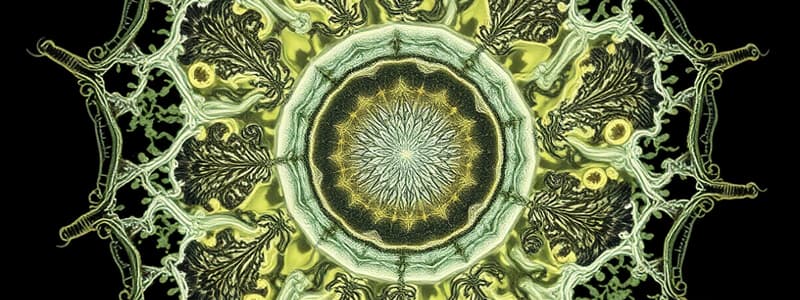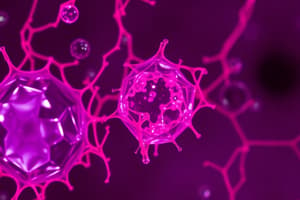Podcast
Questions and Answers
Which of the following best explains the significance of Virchow's work in the context of cell theory?
Which of the following best explains the significance of Virchow's work in the context of cell theory?
- He invented the first microscope, enabling the visualization of cells.
- His endorsement of the concept that cells arise from pre-existing cells increased its acceptance within the scientific community. (correct)
- He discovered that all living organisms are composed of cells.
- He was the first to describe the process of cell division.
According to modern cell theory, what must occur before a pre-existing cell can give rise to fully functioning daughter cells?
According to modern cell theory, what must occur before a pre-existing cell can give rise to fully functioning daughter cells?
- The cell's DNA must replicate to ensure each daughter cell receives a complete set of genetic instructions. (correct)
- The cell must establish connections with other cells to form tissues.
- The cell must increase in size to accommodate new organelles.
- The cell must undergo differentiation to specialize its function.
Which observation provides the strongest evidence for the principle that all living things are composed of cells?
Which observation provides the strongest evidence for the principle that all living things are composed of cells?
- The presence of similar DNA sequences across different species.
- The discovery of atoms and molecules in non-living materials.
- The identification of complex chemical reactions occurring in both living and non-living systems.
- The consistent finding that all examined biological specimens, from bacteria to plants, are made up of cells. (correct)
A scientist observes a new type of cell dividing by mitosis. Based on the principles of cell theory, what can they conclude about this new cell?
A scientist observes a new type of cell dividing by mitosis. Based on the principles of cell theory, what can they conclude about this new cell?
Why is a rock not considered a living organism according to the first principle of cell theory?
Why is a rock not considered a living organism according to the first principle of cell theory?
Considering the modern interpretations of cell theory, which of the options would be the LEAST likely?
Considering the modern interpretations of cell theory, which of the options would be the LEAST likely?
How does the observation that chimpanzees and humans share 98.8% of their DNA relate to cell theory?
How does the observation that chimpanzees and humans share 98.8% of their DNA relate to cell theory?
Which of the following best summarizes the core tenets of classical cell theory?
Which of the following best summarizes the core tenets of classical cell theory?
How did Anton van Leeuwenhoek contribute to the development of cell theory?
How did Anton van Leeuwenhoek contribute to the development of cell theory?
What was the significance of Robert Hooke's observations in the context of cell theory?
What was the significance of Robert Hooke's observations in the context of cell theory?
How did the work of Matthias Schleiden and Theodor Schwann contribute to the formation of cell theory?
How did the work of Matthias Schleiden and Theodor Schwann contribute to the formation of cell theory?
What was the disagreement between Matthias Schleiden and Theodor Schwann regarding cell formation?
What was the disagreement between Matthias Schleiden and Theodor Schwann regarding cell formation?
How did Rudolf Virchow contribute to cell theory?
How did Rudolf Virchow contribute to cell theory?
Which of the following statements reflects the progression of understanding of cell formation within cell theory?
Which of the following statements reflects the progression of understanding of cell formation within cell theory?
Why is the invention of the microscope considered a critical development in the history of cell theory?
Why is the invention of the microscope considered a critical development in the history of cell theory?
Flashcards
Scientific Theory
Scientific Theory
A widely accepted explanation of natural phenomena, supported by a large body of evidence that may evolve with new discoveries.
Cell Theory
Cell Theory
A fundamental biological principle explaining the role of cells in living organisms.
Classical Cell Theory
Classical Cell Theory
- Cells are the basic unit of life. 2. All living things are made of cells. 3. Cells come from other cells.
Anton Van Leeuwenhoek
Anton Van Leeuwenhoek
Signup and view all the flashcards
Robert Hooke
Robert Hooke
Signup and view all the flashcards
Matthias Schleiden
Matthias Schleiden
Signup and view all the flashcards
Theodore Schwann
Theodore Schwann
Signup and view all the flashcards
Rudolf Virchow
Rudolf Virchow
Signup and view all the flashcards
Cell Theory: Principle #1
Cell Theory: Principle #1
Signup and view all the flashcards
Cell Theory: Principle #2
Cell Theory: Principle #2
Signup and view all the flashcards
Cell Theory: Principle #3
Cell Theory: Principle #3
Signup and view all the flashcards
Cell Theory: Genetic Information
Cell Theory: Genetic Information
Signup and view all the flashcards
Cell Theory: Similar Species
Cell Theory: Similar Species
Signup and view all the flashcards
Cell Theory: Energy Flow
Cell Theory: Energy Flow
Signup and view all the flashcards
Cell Theory: Genetic Instructions
Cell Theory: Genetic Instructions
Signup and view all the flashcards
Study Notes
- Cell theory is a widely accepted explanation of the role of cells in living things.
- Classical and modern versions of cell theory exist.
Classical Cell Theory
- Cells are the basic unit of life.
- All living things are made of cells.
- Cells come from other cells.
History of Cell Theory
- The invention of the microscope was critical to the development of cell theory.
- Anton Van Leeuwenhoek observed microorganisms he called "animalcules" using his microscope in the 1600s.
- Robert Hooke coined the term "cell" after observing chambers in cork that resembled monastery rooms.
- Matthias Schleiden concluded that all plants are made of cells.
- Theodore Schwann came to the similar conclusion that all animal samples he studied were made of cells.
- Schleiden believed in free cell formation, or spontaneous generation.
- Schwann believed cells came from preexisting cells.
- Rudolf Virchow supported Schwann's idea and contributed his expertise, leading to wider acceptance of cells coming from other cells.
Three Principles of Cell Theory
Cells are the Basic Unit of Life
- Cells are the building blocks of living things.
- Atoms and molecules must form a cell for something to be considered living.
- Cells combine to form tissues and organs, contributing to the overall function of an organism.
All Living Things are Made of Cells
- Living things can be unicellular, containing a single cell, or multicellular, containing many cells.
- Bacteria are unicellular organisms.
- Plants, animals, and other organisms are multicellular.
Cells Come From Other Cells
- New cells arise from cell division (mitosis and meiosis) of preexisting cells.
- Sexual reproduction involves the formation of sperm and egg cells through cell division.
- Organism growth stems from the division of a zygote formed from a sperm and egg cell.
- New cells also help with tissue repair.
Modern Interpretation of Cell Theory
- Additional discoveries led to more principles that contributed to cell theory, like:
- Genetic information is passed to new cells during cell division.
- Similar species contain cells of extremely similar composition.
- Energy flows within cells.
- Genetic instructions, often in the form of DNA, are stored in cells.
- DNA replicates before cell division to ensure each new cell has a full set of instructions.
- Closely related species have more similarly structured cells.
- Chimpanzees and humans share 98.8% of their DNA, resulting in similar cells.
- Cells can carry out their own energy flow processes, such as photosynthesis in plant cells.
Studying That Suits You
Use AI to generate personalized quizzes and flashcards to suit your learning preferences.




